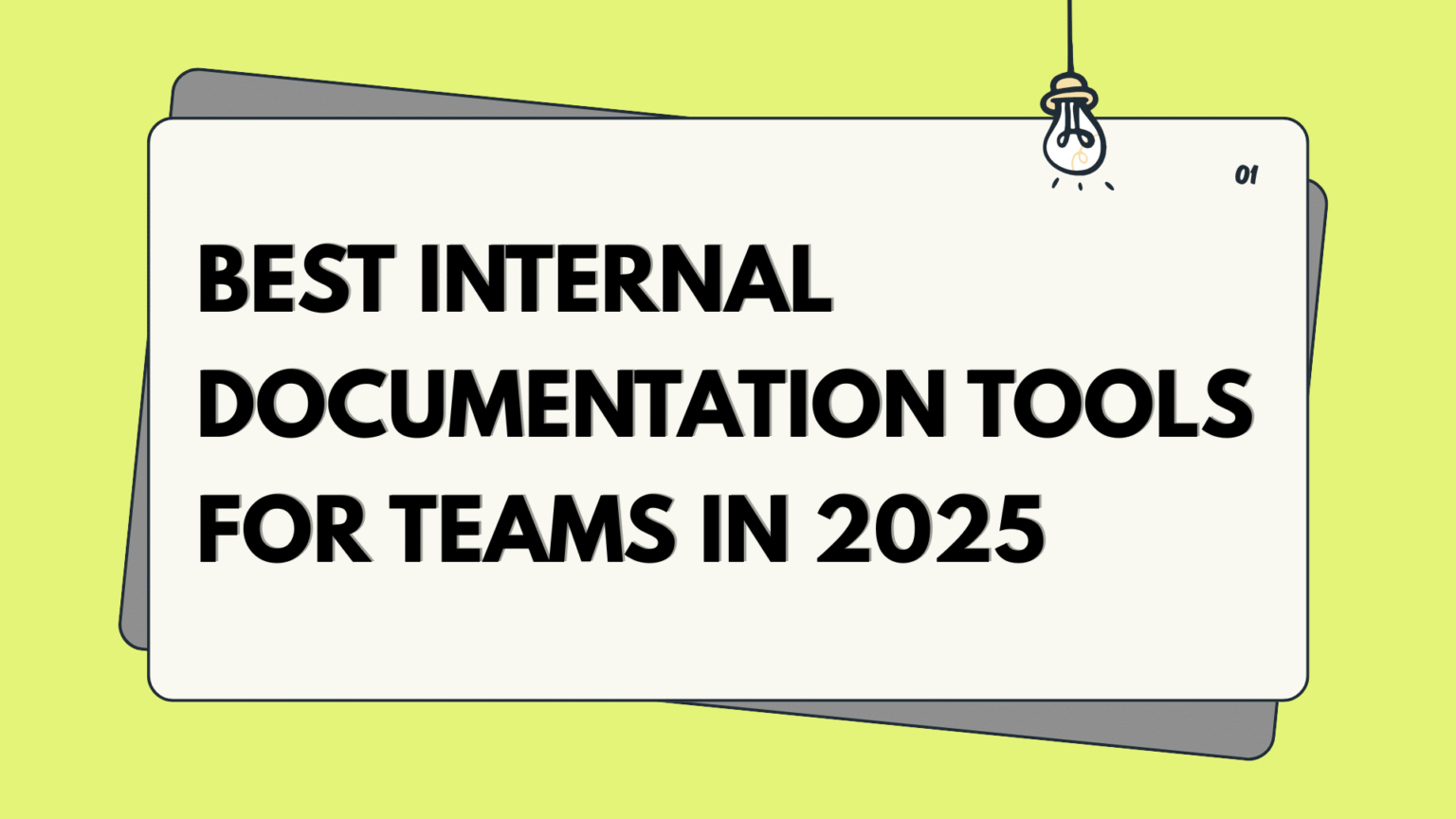Looking for the best internal documentation tools for your team in 2025? Whether you’re leading a startup, an emerging company, or building the operations of a scaling enterprise, a centralized knowledge base should be simple to find and easy to reference.
Adding the proper internal documentation (or knowledge management) tool can increase team productivity, reduce unnecessary communication, and keep everyone aligned and on the same page.
In this guide, we’ll explore the top internal documentation tools teams use in 2025, including their best features, applications, and unique aspects.
What are Internal Documentation Tools
Internal documentation tools are vital platforms that help teams store, categorize, and retrieve internal knowledge, including company policies, onboarding materials, standard operating procedures, and technical documentation.
Internal documentation tools represent centralized knowledge bases that strengthen team alignment, dilute repeated communication, and ensure information is always up to date. Internal documentation tools complement remote work tools in hybrid or remote-first environments to ensure seamless collaboration regardless of location.
Why are internal documentation tools important?
Internal documentation tools play a key role in providing centralized knowledge, reducing repetitive inquiries, and making the onboarding process easier for new staff. Internal documentation ensures that teams can access validated, current, and single-sourced information quickly and at any time, rather than relying solely on their memory.
The need for repeated questions about the same topic will decrease, which means faster decisions, fewer errors, and more alignment between teams.
With employees working in remote and hybrid work environments today, internal documentation tools will continue to complement remote collaborative tools by eliminating as much ambiguity as possible in communications.
In fact, 46% of employees said that they “sometimes or almost always” struggle to find the information they need to carry out their job. Clear and accessible documentation ensures that both synchronous and asynchronous communications remain concise and transparent, keeping everyone as aligned as possible.
Best Internal Documentation Tools for Teams
| Tool | Best For | Key Strengths |
| Notion | Flexible teams, HR, Ops | Modern UI, customizable templates, all-in-one workspace |
| Confluence | Tech teams, large organizations | Jira integration, page hierarchy, version control |
| Guru | Sales, support, fast-paced teams | In-workflow answers, AI verification, browser extension |
| Document360 | SaaS, technical teams, large docs | Markdown support, advanced search, role-based access |
| Slab | Startups, remote teams | Clean UI, easy navigation, lightweight wiki |
| Tettra | Slack/MS Teams users | Q&A format, fast Slack integration |
| Unleash | Large enterprises | AI-powered search, permission mirroring, integrations |
| Stack Overflow Teams | Developer teams | Familiar Q&A format, developer-first experience |
| Helpjuice | Customer support & internal docs | External + internal KBs, analytics, structured content |
1. Notion
Notion is one of the most flexible internal documentation tools for teams in 2025. The software combines note-taking, task tracking, databases, and wikis into a single workspace. It’s a great fit for startups, remote teams, and companies experiencing rapid growth.
Notion is very flexible; not only that, it has a fantastic drag-and-drop interface and lots of great templates, which make it easy for teams to create structured documentation for onboarding, SOPs, HR processes, etc.
Source: Notion
Key Features
- Customizable pages, blocks, and templates.
- Real-time collaboration and comments.
- Robust searching and tagging system.
- Access control and page permissions at the sub-doc level.
- Integrations with Slack, Google Drive, Zoom, GitHub, and more.
- Support for web, desktop, and mobile.
Pricing
- Free: Basic features, unlimited pages, up to 10 guests.
- Plus: $10/user/month.
- Business: $18/user/month.
- Enterprise: Custom.
Pros
- Clean, modern UI.
- Extremely flexible and easy to use.
- Ideal for remote and async teams.
- Tons of templates and community.
Cons
- It can become messy without structure.
- Limited offline capabilities.
- Limited granular version control.
- Might not scale into an extensive enterprise documentation.
Expert Opinion: Peter Gardus
Expert tip
All-in-one workspace combining notes, docs, databases, and project management with AI assistance.
Peter Gardus
2. Confluence
Atlassian’s Confluence is an enterprise-level internal documentation tool that specializes in structured internal knowledge management between technical and non-technical teams. The tool includes page hierarchy functionality, viewability/page version history, and great integration with the Atlassian ecosystem (particularly Jira).
For teams creating documentation that requires scalable and permissioned content, Confluence is a great tool, especially for engineering, product, and enterprise teams.
Source: Confluence
Key features
- Page hierarchy (parent-child) structure.
- Real-time collaboration, inline comments.
- Deep integration with Jira, Trello, and Bitbucket.
- Versioning & History for pages.
- Access restrictions at the space or page level.
- Templates for meeting notes, product specifications, and standard operating procedures (SOPs).
- Enterprise-grade administration and audit tools.
Pricing
- Free: Up to 10 users, 2 GB storage.
- Standard – $6.05/user/month: Unlimited spaces and page versioning.
- Premium – $11.55/user/month: Advanced permissions, analytics, and automation.
- Enterprise – Contact for price: SAML SSO, audit logs, and 24/7 support.
Pros
- Suitable for technical and enterprise documentation.
- Extremely easy to use with other Atlassian applications.
- Better-than-average permission and workflow controls.
- Robust versioning and audit-log history.
Cons
- The User Interface could feel dated or clunky for new users.
- Limited options for customization for non-technical teams.
- Learning curve for smaller or non-technical teams.
3. Guru
Guru is an internal documentation tool designed for fast contextual knowledge. Guru’s approach is much different than that of a typical wiki; Guru puts answers right into your workflow, be it Slack, Salesforce, Chrome, or email. Guru can be especially useful for sales, support, and fast-moving teams who need confirmed, real-time access to info!
Instead of having to sift through folders or wiki articles, Guru provides you with small, AI-verified pieces of content directly when and where you need it. Guru is fundamentally a knowledge assistant, as opposed to a repository of information.
Source: Guru
Key Features
- In-workflow knowledge delivery (Chrome extension, Slack, Teams).
- AI-driven content verification and reminders to make sure info stays up to date.
- Card-based knowledge management.
- Usage analytics to monitor content performance and knowledge gaps.
- Integrations with Slack, Salesforce, Zendesk, Google Workspace, and others.
- Browser extension to get answers anywhere you are online.
Pricing
- Starter: Free up to 3 users.
- Builder: $5/user/month.
- Expert: $10/user/month.
- Enterprise: custom pricing, advanced governance, SSO, and priority support.
5. Document360
Document360 is a robust knowledge base program designed for growing teams that manage internal documentation, product documentation, and self-service portals. Document360 was built for scalability, allowing teams to have everything from internal wikis to customer-facing help centers, all in one central location.
Source: Document360
Key features
- Markdown Editor: A clean writing space with complete Markdown support.
- Version Control: Record changes and roll back to prior versions easily.
- Category Manager: Use a simple drag-and-drop interface to sort your content.
- Team Analytics: Here you can see if any documents are being written, edited or viewed, along with gaps in your documentation.
- Private and Public Access: Build internal documentation and external-facing knowledge bases.
Pricing
- Free trial: 14 days.
- Standard: $149/project/month – for small teams.
- Professional: $299/project/month – which also includes analytics and integrations.
- Business: $399/project/month – which includes private hosting, backups, and advanced permissions.
- Enterprise: custom pricing – which includes SLAs, SSO, and other enterprise security.
Pros
- Highly customizable layout and structure.
- Easy collaboration with role-based access.
- Analytical with content performance.
- Great for technical and non-technical users.
Cons
- Some learning curve for non-technical users.
- It can get pricey as your team grows.
- No real-time collaborative editing similar to Google Docs.
6. Slab
Slab is a cutting-edge, modern knowledge base tool that is designed specifically to help teams make knowledge transfer a better experience. Slab is committed to creating a minimal, user-friendly writing interface that has strong search and integration capabilities to help support knowledge management and onboarding.
Source: Slap
Key features
- Minimal, distraction-free writing interface.
- Nested topics and intuitive organization.
- Collaboration in real-time.
- Unified search across tools (Google Drive, Slack, GitHub).
- Version history and change tracking.
Pricing
- Free Plan: Up to 10 users.
- Startup: $6.67/user/month (billed annually).
- Business: $12.50/user/month (billed annually).
- Enterprise: Custom pricing.
Pros
- Simple to use and onboard.
- Strong integrations with third-party tools.
- Excellent long-term documentation enrichment.
- Strong onboarding features.
Cons
- Limited formatting compared to advanced editors.
- Problems scaling for large teams with complex workflows.
7. Tettra
Tettra is a simple and smart internal knowledge base for growing teams using Slack. It improves a team’s ability to document processes, policies, and answers to frequently asked questions. Using Tettra, teams can decrease repetitive messages and keep internal knowledge organized, accessible, and shareable.
Source: Tettra
Key Features
- Slack Integration: You can ask and answer questions directly from Slack and turn conversations into knowledge.
- Q&A Workflow: Team members can ask questions, assign questions to experts, and turn the questions and answers into documented pages.
- Knowledge Verification: Assigning experts to hold pages accountable to keeping content updated and trustworthy.
- Search: Team members can conveniently find internal documentation with the in-app search or messages from Slack.
- Permissions: Control who can view, edit, and manage content in the workspace.
Pricing
- Free Plan: Basic features, limited to 10 users.
- Scaling Plan: $8/user/month.
- Enterprise Plan: Custom for larger teams who need security, SSO, and advanced admin features.
Pros
- Fast knowledge capture and integration with Slack are seamless.
- User-friendly, straightforward adoption, and easy for non-technical teams.
- Maintaining verified and updated content through assigned ownership.
- Excellent for fast-scaling startups and remote teams.
Cons
- Limited formatting and customization compared to other tools, such as Notion.
- Not ideal for organizations requiring a deep structure or rich features, particularly for large enterprises.
8. Unleash
Unleash is a knowledge management platform designed for large organizations that have complex documentation and search issues. By aggregating data from various sources and utilizing AI-backed search, retrieval-augmented generation, and context-based conversation tools, Unleash delivers accurate and current answers when needed most.
Source: Unleash
Key Features
- Semantic & federated AI search: Understands intent, not stress specific keywords, which makes it more accurate.
- AI chat agents: Ask questions in a conversational setting based on the specific knowledge of the company.
- Knowledge index: Connects and continuously updates content from multiple sources for swift access.
- Permissions & security: Utilizes already defined permissions on files and other services within the organization, ensuring enterprise-level security
- Multi-LLM support & integrations: Works with various language models and integrates with Slack, Salesforce, and Zendesk.
Pricing
- Custom pricing is determined by deployment requirements, user levels, and any additional platform connections.
- Typically, a direct consult is required for mid-sized and large organizations.
Pros
- Highly accurate and contextually relevant search results.
- Transforms documentation into an interactive AI-searchable agent.
- Improves knowledge discovery and onboarding for dispersed teams.
- Reduces overlapping questions within the enterprise with self-service ease.
Cons
- Feature complexity can require significant setup and customization.
- Cost may be higher relative to other simpler tools.
- Primarily focused towards enterprise and not as much for small teams.
9. Stack Overflow Teams
Stack Overflow for Teams is the secure, private version of the extremely popular Stack Overflow Q&A platform designed for internal use by your company. It allows developer teams and technical organizations to collaborate and share knowledge similar to the public platform, with a few improvements.
Source: Stack Overflow Teams
Key Features
- Tagging & categorization: Organizes knowledge to allow people to easily retrieve information.
- Integration with current development tools: Integrates with Slack, Microsoft Teams, Jira, GitHub, etc.
- Search powered by Stack Overflow’s search algorithm: Can quickly deliver the best answer to internal queries.
- Access control: Sets secure permissions for sensitive information.
- Analytics & insights – Provides insights into engagement, unanswered questions, and popular topics.
Pricing
- Free Plan: Up to 50 users, basic features only.
- Basic: $6.50/user/month billed annually.
- Business: $13/user/month billed annually with SSO, analytics and priority support.
- Enterprise: Custom pricing with advanced security features and admin rights.
Pros
- Ideal for technical and developer organizations
- Familiar graphical interface aids in adoption.
- Reduces repetitive questions and allows people to work more productively.
- Excellent integration with engineering workflows.
- Works on all scales of operation, from small companies to much larger companies.
Cons
- Not built for non-technical organizations or general documentation alternatives.
- May have to moderate content to ensure quality.
- Works much better if the team’s culture is one that encourages participation.
10. Helpjuice
Helpjuice is a valuable knowledge base platform designed to assist organizations, particularly those in the customer service field, in managing internal documents and articles, as well as customer-facing documentation.
Helpjuice has a simple editor and offers various branding and user experience options, allowing teams to centralize knowledge, reduce the number of support tickets received, and simplify employee onboarding.
Source: Helpjuice
Key Features
- Intuitive Editor: WYSIWYG, Markdown, rich-text, and multimedia embeds
- AI Search & Chatbot: fast – smart search and an AI chatbot (Swifty) for self-service rating.
- Customization & Theming: totally brandable interface and basic custom theme capabilities.
- Advanced Analytics: Usage data, insights for optimizing, and finding gaps in the documentation.
Pricing
- Basic: $249/month for ~30 users.
- AI-Knowledge Base: $449/month.
- Unlimited AI-Knowledge Base: $799/month.
Pros
- Helpful and simple visual interface, great for non-technical users.
- Excellent capabilities for customization and branding.
- Great for consolidating internal/external knowledge.
- AI-powered automation keeps documentation up to date.
- Responsive and helpful customer service and onboarding.
Cons
- Pricing may be high for small teams; plans start at $120/month.
- A small portion of users mention limitations in their intended uses of search or content management (like organizing images).
- Instituted glitches with real-time collaboration and editor stability.
- While AI features are useful, they lack the fine-tuning and personalization typically required for complex use cases.
Conclusion
By 2025, the top internal documentation tools will do more than just store information; they’ll help keep teams aligned, improve communication, and make knowledge easier to find. The best option for you depends on your team’s size, workflow, and goals, but a good knowledge base will enhance productivity, smooth out onboarding, and capture important knowledge.
Frequently Asked Questions





